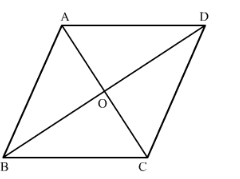Each side of a rhombus is 10 cm. If one its diagonals is 16 cm find the length of the other diagonal.
Each side of a rhombus is 10 cm. If one its diagonals is 16 cm find the length of the other diagonal.
We know that a quadrilateral is said to a rhombus if all sides of the quadrilateral are equal. Diagonals of a rhombus bisect each other at right angles.
Quadrilateral ABCD is a rhombus and diagonals AC and BD intersect at point O.

As we defined above, we get $\mathrm{AB}=\mathrm{BC}=\mathrm{CD}=\mathrm{AD}, \mathrm{AO}=\mathrm{OC}, \mathrm{BO}=\mathrm{OD}$ and angle $\angle \mathrm{AOD}=\angle \mathrm{AOB}=\angle B O C=\angle C O D=90^{\circ}$.
We are given that AB = 10 cm and AC = 16 cm. Now we will find length of BD.
As we know the definition of rhombus we get AB = BC = CD = AD.
Therefore, we get, AB = BC = CD = AD = 10 cm
Also we know that diagonals of rhombus bisect each other at right angles therefore, we get,
$\mathrm{AO}=\mathrm{OC}$
$\mathrm{BO}=\mathrm{OD}$
and $\angle \mathrm{AOD}=\angle \mathrm{AOB}=\angle B O C=\angle C O D=90^{\circ}$
Here, we know the length of $A C$ therefore, we get, $A O=O C=8 \mathrm{~cm}$.
Now we will use Pythagoras theorem in the right angled triangle AOD as below,
$\mathrm{AD}^{2}=\mathrm{AO}^{2}+\mathrm{OD}^{2}$.....(1)
Now we will substitute the values of AD and AO in equation (1) we get,
$10^{2}=8^{2}+O D^{2}$
$100=64+O D^{2}$...(2)
Now we will subtract 64 from both sides of the equation (2)
$O D^{2}=100-64$
$O D^{2}=36$
Now we will take the square root.
OD = 6
We know that $B D=2 O D$
$\therefore B D=2 \times 6$
$\therefore B D=12$
Therefore, length of the other diagonal is $12 \mathrm{~cm}$.
Click here to get exam-ready with eSaral
For making your preparation journey smoother of JEE, NEET and Class 8 to 10, grab our app now.
